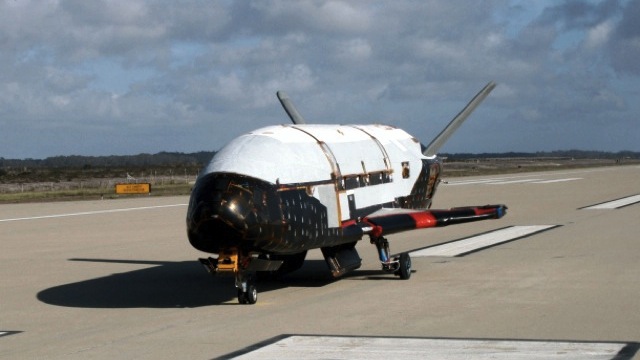The US air force launched the second un-piloted X-37B space plane into low-Earth orbit on Saturday. While the nine-metre-long drone’s mission is mysterious, a trawl of the patents filed by its maker, Boeing, before the plane became a secret “black” programme of the Department of defence in 2004, throws some light on the technology it is packing.
The air force launched the first space plane on an Atlas V rocket in April 2010. The craft, one-quarter the length of the space shuttle, then spent nearly eight months in space, occasionally shifting its orbit with onboard thrusters. It landed in December – allegedly without human intervention, coming to a stop in front of air force engineers in heatproof suits.
Now a second X-37B, called the Orbital Test Vehicle 2, is in low-Earth orbit, after launching on an Atlas V rocket on 5 March from Cape Canaveral, Florida. While its purpose remains a mystery, Troy Giese, X-37B program manager, says one of the aims of the mission is to examine the performance of the spacecraft’s solar panel systems, which are of a novel design.
A US patent issued on 24 June 2003 sheds some light on what that design may be – assuming it was used in the plane’s construction.
Boeing reveals in the patent that the solar array has been designed to permit fast folding and stowing. The reason? So the X-37B can fold the solar array away, fire its thrusters and change its orbit to confound adversaries. This would be useful for satellites, too, says Boeing: “The ability to completely re-stow would offer mission flexibility to move the satellite thus making its orbit unpredictable.”
Moving the plane with the array deployed could put strain on the arm holding the panels and might also increase strikes from micrometeorites, which could damage the panels.
The X37-B solar array hugs the interior of the payload bay doors(Image: USPTO)
Boeing’s answer is to have the solar array conform to the inner surface of the payload pay – see picture, above – a move which avoids the need for bulky latches to hold a folded array flat. Instead, it just rests on fixed mountings inside the bay doors – and its 0.2-cubic-metre volume means very little payload volume is lost.
In a separate US patent issued on 13 January 2004, Boeing reveals how it handles another aspect of the diminutive drone’s problems: the astonishing heat on its ultrathin control surfaces on atmospheric re-entry.
The X-37B uses rotatable, swept-sideways rear tailfins called “ruddervators” to control the plane’s pitch (up or down angle) and yaw (side-to-side movement).
Prior to this 2004 patent, Boeing says the trend was to design such fins by fixing a heat-proof skin over a ceramic carbon composite frame. Their innovation – and the patent still has 13 of its 20 years in force – was to work out how to make most of the ruddervator from one piece of graphite composite. The advantage: it’s easy to make, cuts mass and yet is just as temperature resistant.
Doubtless much has happened since the X-37B became a black program. Guessing its purpose is the big bugbear for the wider media. USA Today hints at the possible “deployment and retrieval of a clandestine payload”. CNET news suggests the project could lead to the militarisation of space.
However one leading expert doubts the plane is designed to attack orbiting satellites. If it were intended for such “counterspace” operations, it would be going about it in a wasteful way, says Laura Grego of the Union of Concerned Scientists in Massachusetts.
“There are a lot of cheaper and simpler ways to do counterspace operations than to use an X-37B,” she recently told New Scientist. “The really new technology they are testing is the ability to land back on a runway. If counterspace were the priority, you wouldn’t use all that extra mass to have the ability to fly back to Earth – instead you’d use that mass for fuel so you can do more nefarious things.”
“So there seems no good, defined purpose for this thing and I’m not sure why it went ahead,” she says. “Was it bureaucratic inertia that made the project go ahead? We just don’t know.”
